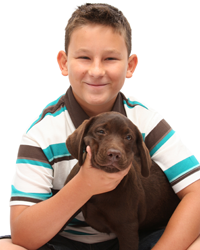Vigilance is Key to Preventing a Bite

The AVMA estimates that of the children under the age of 18 who have been bitten: family dogs are responsible for 30% of the bites, while the neighbor’s dog is responsible for another 50% of the bites. Never assume because the child and dog know each other that they are fine together.
Whether you have a dog or not, take a minute to read over these helpful tips to preventing dog bites from Heidi Ganahl, CEO and founder of Camp Bow Wow. We all encounter dogs almost daily.These 10 tips might just save you a trip to the hospital. It might also save your dog’s life – many times an offending dog will be euthanized.
Pet Personalities. Dog owners should always understand (through training) their dog’s personality and limitations. Owners should not put dogs into situations where they feel anxious, nervous or afraid – this is a recipe for a dog bite encounter. Most aggression is fear-based and most bites are preventable if the owner takes some time to understand their dog.
Pets and Socialization. Socialize your pet at early stages in his development. This will allow your pet to feel at ease around people and other animals in social settings. Socializing your dog can have a tremendous effect on his interactions both at home and in public. Newly socialized dogs become calmer, friendly, affectionate, and can adapt better to a new environment.
Training Techniques. Train your dog or hire a professional to do so. Basic commands such as “Sit” and “Stay” help dogs understand what is expected of them. Training can also be incorporated into fun activities that establish the owner as an authoritative figure, yet strengthen the bond between owner and dog as companion and friend.
Space and Body Language. Respect the dog’s space. Never stand over a dog or stare at the dog while hovering above him. This is a direct threat in the dog’s language and may provoke a bite because the dog is afraid or intimidated.
Pets and Children. Children are the most common victims of dog bites. Never leave a child under 10 years old alone with a dog, no matter how much you trust your four-legged friend. Children should always ask before petting a dog, and parents and dog owners should observe and supervise the interaction between dog and child with even the most child-friendly dog.
Children and Aggressive Behavior. Children should never get in a dogs face or grab the dog in an aggressive way. Dogs tend to give warnings when they are uncomfortable and may bite in response. In most cases, children aren’t able to pick up on these signals and can easily get hurt.
Dogs in Chains. Never chain or tether your dog in the backyard or any other area. Dogs who are chained up feel increased levels of stress and protectiveness. A dog that is confined and feels threatened will defend himself and is more likely to bite.
Security in Public. Pet owners should always use a leash to ensure that they are able to control their dog in public settings. If the pet becomes excited or anxious for any reason, pet owners should draw him near and gently pat his head or rub his fur to calm him down.
Security at Home. If your home has a fenced yard, make sure gates are always secure. This will prevent Fido from running off into public spaces and interacting with others without your supervision.
Pet Health. A healthy pet is a happy pet. Make sure that your dog visits a veterinarian annually, receives proper exercise, and is vaccinated against rabies and preventable diseases. Remember, how your dog feels affects how he behaves.
View the DogChannel behavior center for more signs and corrective actions for dog’s that bite. More>>
The following are tips provided by the CDC on what to do if you or your child is bitten:
Rinse the bite area with soapy water.
Elevate limb(s) that have been bitten.
Apply antiseptic lotion or cream. Watch the area for signs of infection for several days after the incident.
For deeper bites or puncture wounds, apply pressure with a clean bandage or towel to stop the bleeding. Then wash the wound, dry it and cover with a sterile dressing. Don’t use tape or butterfly bandages to close the wound.
It’s a good idea to call your child’s physician because a bite could require antibiotics or a tetanus shot. The doctor also can help you to report the incident.
If your child is bitten severely, call 9-1-1 or go to the emergency room.
When going to the emergency room, advise the personnel of:
a. your tetanus vaccination status
b. vaccine status of the dog
c. who the dog owner is; and
d. if the dog has bitten before
Remember, vigilance is key in any situation where your dog is around other people and animals. Never assume you know what your dog is going to do – that’s like assuming you know what the person next to you is thinking or going to do – it’s a recipe for disaster.





